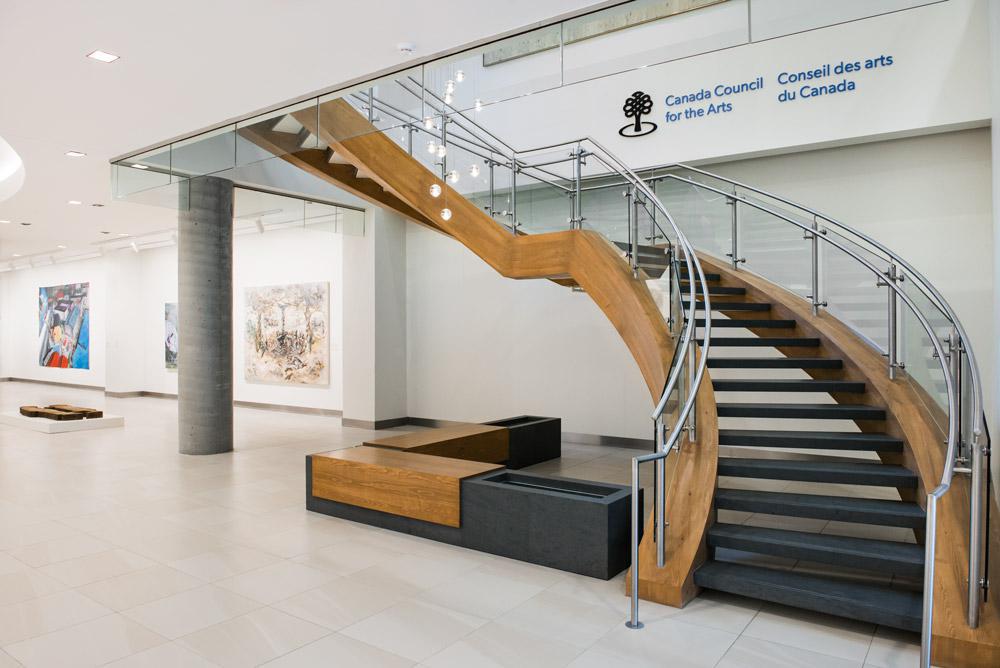Over the past 40 years, the Canada Council Art Bank has collected more than 17,000 artworks that go on loan regularly to public and private exhibition spaces across Canada.
But it hasn’t had a proper, dedicated spot to exhibit Art Bank works itself—until today.
This morning, media got a preview of Âjagemô, the Canada Council’s new 3,000-square-foot exhibition hall at the base of the council’s offices at 150 Elgin Street in Ottawa.
Named after the Algonquin word for “crossroads,” Âjagemô provides a fresh opportunity for Canadians to engage with their art.
“This is really the first time we have had a major exhibition space where we can provide exhibitions in a way that does justice to the artwork,” says Art Bank director Victoria Henry. “This is a chance to show how expansive and important the collection is.”
The first exhibition at Âjagemô, for instance, features works by Shuvinai Ashoona, Kim Adams, Michael Snow, Liz Magor and nine other leading Canadian artists. Titled “Land Reform(ed),” the exhibition addressing the landscape—a classic Canadian theme.
“This selection of works actually covers the whole 40 years” of the Art Bank, Henry says. “It’s a fascinating snapshot.”
“Land Reform(ed)” also includes a new Art Bank acquisition—a traditional birchbark canoe handcrafted by Algonquin elder Daniel (Pincock) Smith. The artwork, like the name of the gallery, acknowledges that the building sits on traditional Algonquin lands.
But while the gallery space is newly (and permanently) available to the Canada Council and its Art Bank, funds dedicated to it are not.
“We’re doing it with existing monies,” Henry says. “We have found monies in our own resources to pay exhibition fees [to artists for this first exhibition]… and much of the marketing and communications will be completely done in-house.”
Reflecting this sense of budgetary restraint, “Land Reform(ed)” was curated by Stanzie Tooth, a University of Ottawa MFA candidate, through an internship program. (Granted, Tooth has more experience than the average MFA student might when it comes to curating and installing a professional exhibition; she worked at Toronto’s Lonsdale Gallery for several years prior to starting her graduate degree.)
Also, the Âjagemô space was originally planned as a concert hall—but when that fell through, the concept of a gallery dedicated to the Art Bank collection and other public arts events emerged.
“We are starting to work on [the next exhibition] now,” Henry says, noting that all works will again be from the Art Bank collection and possibly curated in-house. “It will be artworks selected from the past 15 years of the Governor General’s Awards in Visual and Media Arts…with the idea that the show will end with the announcement of the 2015 winners.”
Another project on the horizon for April and May 2015 an exhibition related to the Ottawa-wide Ontario Scene festival, which is coordinated by the National Arts Centre.
Overall, Henry says, she hopes Âjagemô can be a place where not only the public engages with the Art Bank collection, but students and curators as well.
“We are open to research by curators and students and anyone who wants to understand what we have,” Henry says, noting she is also open to future exhibition proposals and ideas from same.
Âjagemô’s first exhibition “Land Reform(ed)” opens to the public on June 18. Gallery hours are 8 a.m. to 6 p.m. Monday to Friday.









